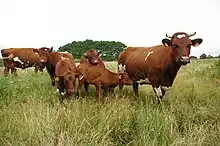 | |
| Conservation status | FAO (2007): critical[1]: 136 |
|---|---|
| Other names | Armorican |
| Country of origin | France |
| Distribution | Brittany |
| Use | dual-purpose, meat and milk |
| Traits | |
| Weight | |
| Height | |
| Skin colour | pale |
| Coat | red with some white markings |
| Horn status | horned in both sexes |
| |

The Armoricaine or Armorican is an endangered French breed of domestic cattle. It originated in Brittany in the nineteenth century. It has a red coat with white markings, and has short horns.
History
The Armoricaine was created in the nineteenth century by cross-breeding animals of the local Froment du Léon and the now-extinct Pie Rouge de Carhaix breeds with imported Durham (now known as Shorthorn) stock from the United Kingdom.[3][4] A herd-book was started in 1919,[5] and the Armoricaine breed name came into use in 1923.[6]
The Armoricaine was used, with Meuse-Rhine-Issel and Rotbunt stock, in the creation of the Pie Rouge des Plaines dairy breed of cattle in the 1960s.[7] In the later twentieth century it became rare; by 1978 there were no more than forty cows remaining. Following the discovery of a reserve of frozen semen in the 1980s, a programme of recovery was launched.[2]: 113 In 2001 there were 61 cows registered, and 10 bulls; semen from 18 bulls was preserved and available for artificial insemination.[4]
The breed was listed by the FAO as "critically endangered" in 2007;[1]: 136 in 2005, the population was estimated at about 240 head,[3] and in 2014 it was 263.[5] In 2020 there were 301 cows on 81 farms.[8]
Description
The coat is red, with some white markings. The horns are short. Cows weigh about 650 kg, and stand about 138 cm at the withers.[5]
Use
The Armoricaine is a dual-purpose breed, and may be raised both for meat and for milk. Cows produce some 4500 L of milk in a lactation of about 305 days.[3] The young grow quickly, and mature animals fatten quickly.[8]
References
- 1 2 Barbara Rischkowsky, D. Pilling (eds.) (2007). List of breeds documented in the Global Databank for Animal Genetic Resources, annex to The State of the World's Animal Genetic Resources for Food and Agriculture. Rome: Food and Agriculture Organization of the United Nations. ISBN 9789251057629. Accessed November 2016.
- 1 2 3 4 Valerie Porter, Lawrence Alderson, Stephen J.G. Hall, D. Phillip Sponenberg (2016). Mason's World Encyclopedia of Livestock Breeds and Breeding (sixth edition). Wallingford: CABI. ISBN 9781780647944.
- 1 2 3 4 Étude de la race bovine: Armoricaine (in French). Bureau des Ressources Génétiques. Archived 17 May 2015.
- 1 2 Breed description: Armorican. Department of Animal Breeding and Genetics, School of Veterinary Medicine Hannover. Archived 15 October 2007.
- 1 2 3 Breed data sheet: Armoricaine/France. Domestic Animal Diversity Information System of the Food and Agriculture Organization of the United Nations. Accessed November 2016.
- ↑ Armoricaine Cattle Breed. Slow Food Foundation. Accessed November 2016.
- ↑ Breed data sheet: Pie Rouge Des Plaines/France. Domestic Animal Diversity Information System of the Food and Agriculture Organization of the United Nations. Accessed November 2016.
- 1 2 Beef breeds: Conservation breeds. Institut de l'Elevage et Races de France. Archived 27 October 2020.